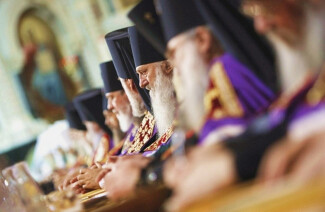A Word About Church History
![]()
A Word About Church History
Scholars estimate over 2,600 groups today lay claim to being the Church, or at least direct descendants of the Church as described in the New Testament. Repeat: 2600!
But for the first one thousand years of her history, the Church was essentially one. Five Patriarchal centers, each of them similar to a modern day diocese, were founded by the Apostles forming a cohesive whole; and since there was complete theological communion and equal authority between each of the Apostles, there was also complete theological communion and equal authority between each of the Patriarchates. The five original Patriarchates were altogether called The Pentarchy.
The Five Original Apostolic Patriarchates ("The Pentarchy")
1. Antioch (the Apostles Peter and Paul)
2. Jerusalem (the Apostle James)
3. Constantinople (the Apostle Andrew)
4. Alexandria (the Apostle Mark)
5. Rome (the Apostle Peter)
All of the apostles worked together to found and establish The Pentarchy, but the above listed apostles played especially prominent roles.
Following the apostles were occasional heretical or schismatic groups going their own way, to be sure; but The Pentarchy remained in full communion until the 11th century. Then, in events culminating in A.D.1054, the Roman Patriarch (or 'Pope') pulled away from the other four to pursue his long-developing claim of universal headship over the entire Church. This event is known as The Great Schism. Today, nearly one thousand years after The Great Schism, the original four Patriarchates still remain intact and in full theological communion with each other. With the addition of five more, there are now a total of nine Patriarchates:
The Nine Patriarchates of Today (including the original four)
 1. Antioch (Apostle Peter)
1. Antioch (Apostle Peter)
2. Jerusalem (Apostle James)
3. Constantinople (Apostle Andrew)
4. Alexandria (Apostle Mark)
5. Georgia (Apostle Andrew; recognized in 486 A.D.)
6. Bulgaria (927 A.D.)
7. Serbia (1219 A.D.)
8. Russia (1589 A.D.)
9. Romania (1885 A.D.)
The Orthodox Church and her history is described herein, from Pentecost to the present day.

33 Pentecost (A.D: 29 is thought to be more accurate).
49 Council at Jerusalem (Acts 15) establishes precedent for addressing Church disputes in Council. James presides as bishop.
69 Bishop Ignatius consecrated in Antioch in heart of New Testament era--St. Peter had been the first bishop there. Other early bishops include James, Polycarp, and Clement.
95 Book of Revelation written, the last of the New Testament books.
150 St. Justin Martyr describe's the worship of the Church centered around Holy Communion - the Body and Blood of Christ - as liturgically transformed from the Levitical worship services.
325 The first draft of the Nicene Creed is established. The Council at Nicaea settles the first major heretical challenge by Arius, who asserted that Christ was created and not eternally begotten of the Father. The Council of Nicaea is the first of Seven Ecumenical (Church-wide) Councils.
451 Council of Chalcedon affirms the apostolic doctrine of the two natures of Christ.
589 In a synod in Toledo, Spain, the filioque, asserting that the Holy Spirit procedes from the Father and the Son is added to the Nicene Creed. This error is later adopted only by the Church of Rome.
787 The era of Ecumenical Councils ends at Nicea, with the Seventh Council bringing the centuries-old use of icons back into the Church.
988 The Conversion of Russia begins as envoys sent by Russian Prince Vladimir report back to him their experiences while attending Divine Liturgy at the Church of the Hagia Sophia in Constantinople.
"We knew not whether we were in heaven or on earth, for surely there is no such splendour or beauty anywhere upon earth. We cannot describe it to you: only this we know, that God dwells there among men, and that their service surpasses the worship of all other places. For we cannot forget that beauty."
1054 The Great Schism occurs. Two major issues include Rome's claim to a universal papal supremacy and her addition of the filioque clause to the Nicene Creed. The Photian schism (880) further complicated the debate.
1095 The Crusades by the Roman Catholic Church. The Sack of Constantinople by Rome (1204) adds to the estrangement between East and West.
1333 St. Gregory Palamas defends the Orthodox practice of hesychast spirituality and the use of the Jesus prayer.
1453 Muslim Turks overrun Constantinople and the Byzantine Empire ends. Priests are murdered along with the Christian faithful as Muslims desecrate Churches and convert them into Mosques by adding minarets (towers). The vast majority of Mosques now have domes, and the overall floor plan is normally in the style of an Orthodox Church; except for the crescent moon replacing the cross amongst other things.
1517 Martin Luther nails his 95 Theses to the door of the Roman Church in Wittenberg, starting the Protestant Reformation.
1529 Church of England begins to pull away from Rome.
1794 Missionaries arrive on Kodiak Island in Alaska; Orthodoxy introduced to North America.
1854 Rome establishes the Immaculate Conception dogma.
1870 Papal Infallibility becomes Roman Catholic Dogma.





